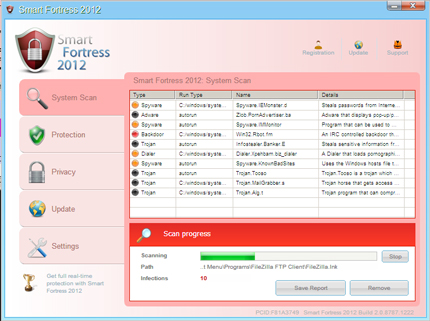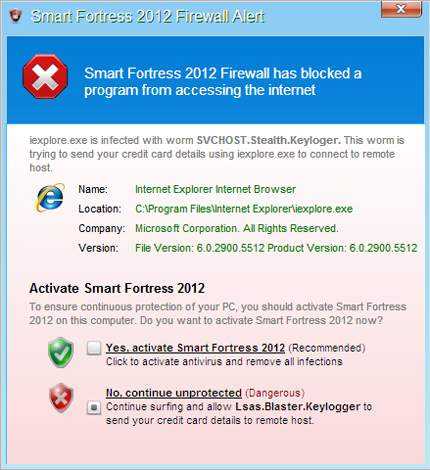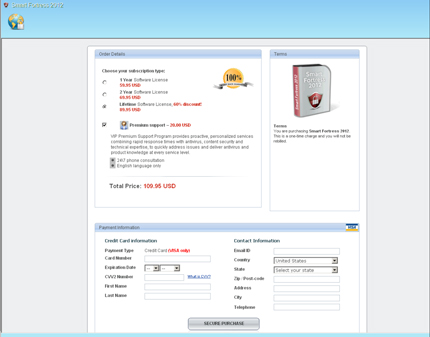TROJ_FAKEAV.GBO
Trojan.Win32.FakeAV.kyvc (Kaspersky); Mal/FakeAV-QL (Sophos)
Windows 2000, Windows XP, Windows Server 2003


Threat Type: Trojan
Destructiveness: No
Encrypted: Yes
In the wild: Yes
TECHNICAL DETAILS
Installation
This Trojan drops the following files:
- %System Root%\Documents and Settings\All Users\Application Data\{random}\{random} - encypted component
- %User Desktop%\Smart Fortress 2012.lnk - shortcut file
- %Start Menu%\Programs\Smart Fortress 2012\Smart Fortress 2012.lnk - shortcut file
(Note: %System Root% is the root folder, which is usually C:\. It is also where the operating system is located.. %Start Menu% is the current user's Start Menu folder, which is usually C:\Windows\Profiles\{user name}\Start Menu on Windows 98 and ME, C:\WINNT\Profiles\{user name}\Start Menu on Windows NT and C:\Windows\Start Menu or C:\Documents and Settings\{User name}\Start Menu on Windows 2000, XP, and Server 2003.)
It drops the following copies of itself into the affected system:
- %System Root%\Documents and Settings\All Users\Application Data\{random}\{random}.exe
(Note: %System Root% is the root folder, which is usually C:\. It is also where the operating system is located.)
It creates the following folders:
- %System Root%\Documents and Settings\All Users\Application Data\{random}
- %Start Menu%\Programs\Smart Fortress 2012
(Note: %System Root% is the root folder, which is usually C:\. It is also where the operating system is located.. %Start Menu% is the current user's Start Menu folder, which is usually C:\Windows\Profiles\{user name}\Start Menu on Windows 98 and ME, C:\WINNT\Profiles\{user name}\Start Menu on Windows NT and C:\Windows\Start Menu or C:\Documents and Settings\{User name}\Start Menu on Windows 2000, XP, and Server 2003.)
Other System Modifications
This Trojan adds the following registry keys:
HKEY_CLASSES_ROOT\%s
HKEY_CURRENT_USER\Software\Microsoft\
Windows\CurrentVersion\Uninstall\
Smart Fortress 2012
HKEY_CLASSES_ROOT\F4D55
It adds the following registry entries:
HKEY_CLASSES_ROOT\F4D55\shell\
open\command
@ = "%System Root%\Documents and Settings\All Users\Application Data\{random}\{random}.exe" -s "%1" %*
It modifies the following registry entries:
HKEY_CLASSES_ROOT\.exe
@ = F4D55
(Note: The default value data of the said registry entry is exefile.)
NOTES:
Upon execution, it displays the following fake alerts:



It displays fake alerts that warn users of infection. It also displays fake scanning results of the affected system. It then asks for users to purchase it once scanning is completed. If users decide to purchase the rogue product, users are directed to the following fake purchase site asking for sensitive information, such as credit card numbers:
- http://{BLOCKED}8.{BLOCKED}9.101.184
Below is a screenshot of the fake purchase page:

The following registries are added/modified so that it the malware runs every time an executable file is executed by the affected user:
HKEY_CLASSES_ROOT\F4D55\shell\open\command
@ = ""%System Root%\Documents and Settings\All Users\Application Data\{random}\{random}.exe" -s"
HKEY_CLASSES_ROOT\.exe
@ = "F4D55"
SOLUTION
Step 1
For Windows XP and Windows Server 2003 users, before doing any scans, please make sure you disable System Restore to allow full scanning of your computer.
Step 2
Identify and delete files detected as TROJ_FAKEAV.GBO using either the Startup Disk or Recovery Console
Step 3
Search and delete these folders
Step 4
Search and delete this file
Step 5
Delete this registry key
Important: Editing the Windows Registry incorrectly can lead to irreversible system malfunction. Please do this step only if you know how or you can ask assistance from your system administrator. Else, check this Microsoft article first before modifying your computer's registry.
- In HKEY_CLASSES_ROOT
- %s
- %s
- In HKEY_CURRENT_USER\Software\Microsoft\Windows\CurrentVersion\Uninstall
- Smart Fortress 2012
- Smart Fortress 2012
- In HKEY_CLASSES_ROOT
- F4D55
- F4D55
Step 6
Restore this modified registry value
Important: Editing the Windows Registry incorrectly can lead to irreversible system malfunction. Please do this step only if you know how or you can ask assistance from your system administrator. Else, check this Microsoft article first before modifying your computer's registry.
- In HKEY_CLASSES_ROOT\.exe
- From: @ = "F4D55"
To: @ = "exefile"
- From: @ = "F4D55"
Step 7
Scan your computer with your Trend Micro product to delete files detected as TROJ_FAKEAV.GBO. If the detected files have already been cleaned, deleted, or quarantined by your Trend Micro product, no further step is required. You may opt to simply delete the quarantined files. Please check this Knowledge Base page for more information.
Did this description help? Tell us how we did.

